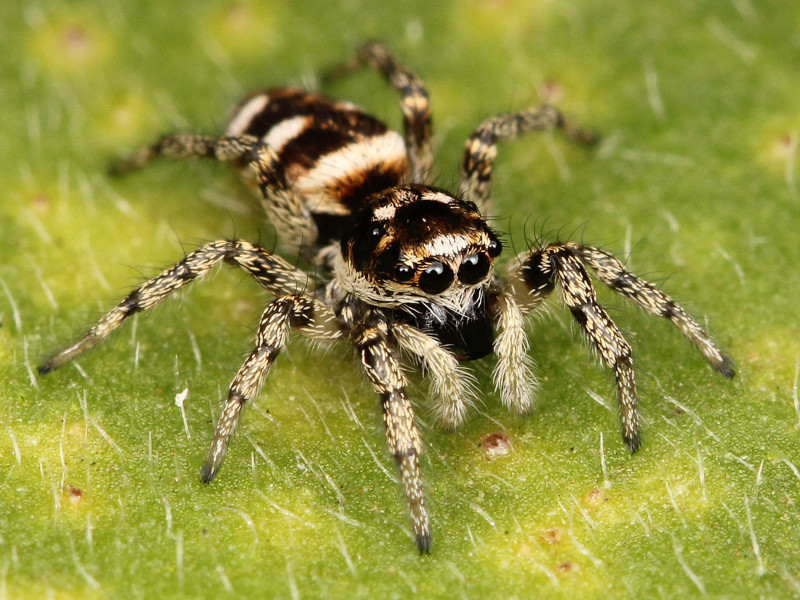
Zebra Spider Facts
- This remarkable arachnid most frequently goes by the descriptive common name of the Zebra Spider for the obvious reason. The creature does have one other, very similar general name, though. That’s the nearly identical term of the Zebra Jumping Spider.
- Within scientific circles, however, it’s better known by its technical title. Thankfully, that’s a much simpler term for the layperson to pronounce than most such names. That’s because this wonder of Nature bears the official moniker of Salticus scenicus.
- The intriguing Arthropod received that name due to the efforts of the respected Swedish entomologist and arachnologist, Carl Alexander Clarck. He accompllished the first recorded acknowledgement of it as a separate and distinct species in 1757.
- Regardless of which title one chooses to employ, though, it remains an interesting species. Its common name derives from a combination of 2 factors. The first, naturally, is its pattern of coloring. The second is its ability and tendency to jump.
- Fortunately, the Zebra Spider appears to be maintaining a population base that’s both sizeable and stable. That trend also seems to hold true throughout the entirety of its native range. The IUCN, therefore, currently has no listing for it on the Red List.
- Nevertheless, it must be considered to be facing at least some potential threats to its existence. Most of these stem directly from the actions of humans. They include habitat degradation and loss. Its greatest danger, though, likely comes from climate change.
Related Articles
Brown Recluse Spider
Zebra Spider Physical Description
The fascinating Zebra Spider typically captures the imagination of those fortunate to encounter one. Although it does so for a variety of reasons, sheer phsyical size isn’t usually among them. That’s true since this arachnid ranks as relatively small among its kindred.
Like many of those same relatives, though, the spider displays a certain degree of the physiological characteristic of sexual dimorphism. Continuing to follow the patterns of its kind, this trait manifests itself more in terms of physical size, than in physical appearance.
Females of the remarkable species attain a larger average size than their male counterparts. Those females typically grow to between 0.2 – 0.35 in (5 – 9 mm) in body length. Males, however, only average roughly 0.2 – 0.24 in (5 – 6 mm) in that same dimension.
The Arthropod does display a small element of gender-based difference in another way, though. That presents itself in regards to the mouth of the invertebrate. That’s because, though smaller overall, the males develop significantly larger jaws than the females.
Like all other spiders, the Zebra Spider also has a total of eight eyes. Two of these orbs stand out, however. These appear on the top front of the head, and reach a much greater size than the rest of the eyes. This provides the arachnid with virtual binocular vision.
Yet it’s the coloring of the aptly-named spider that catches the most attention, and serves as the source of the common name. The background color of the body presents as a deep black shade. Numerous white hairs devlop, though, and grow in zebra-like stripes on the body.
- Kingdom: Animalia
- Phylum: Arthropoda
- Class: Arachnida
- Order: Araneae
- Family: Salticidae
- Genus: Salticus
- Species: S. scenicus
Zebra Spider Distribution, Habitat, and Ecology
Incredibly, the amazing Zebra Spider evolved as native to an extraordinarily broad swathe of the globe. The nature and extent of that zone of habitation may surprise you, though. That’s due to the fact that the Arthropod appears throughout most of the Northern Hemisphere!
That astounding territory comprises the entirety of North America. The intrepid marvel of Nature further lives in all regions of Europe, as well. But it doesn’t stop there, however. That’s because the small spider additionally appears in most of the northern part of Asia.
Much like of many of its relatives, the invertebrate also displays decided preferences regarding its choice of habitat. As a general principle, it lives in mostly open, vertical regions. That includes shingle beaches, rock faces, and sometimes the trunks of trees.
Yet it doesn’t shy away from making its home near human habitation, as well. This frequently consists of such surprising locations as fences around gardens, and even the walls of buildings. Some even move intside structures, often living in the corner of windowsills.
Like virtually all other arachnids, the dazzling Zebra Spider evolved as entirely carnivorous in nature. Despite its small stature, it feeds on a wide variety of arthropods, including other, even smaller spiders. It doesn’t build webs, but stalks its prey, and pounces on it.
The species breeds during the spring and summer. Like many jumping spiders, males conduct a type of courtship dance to attract females. If the female is impressed with his dance, she will allow him to approach. If she isn’t though, he might be treated as prey!
Species Sharing Its Range
Check out our other articles on 5 Marvelous Mediterranean Sea Species, Eastern Gray Squirrel, Vintgar Gorge, Red Maple, European Honey Buzzard, Blue-winged Wasp, Philippine sailfin lizard
